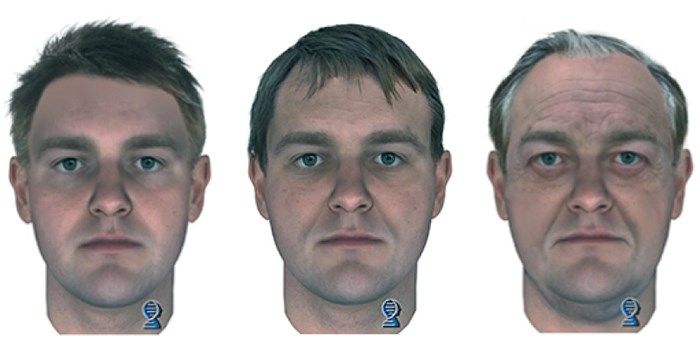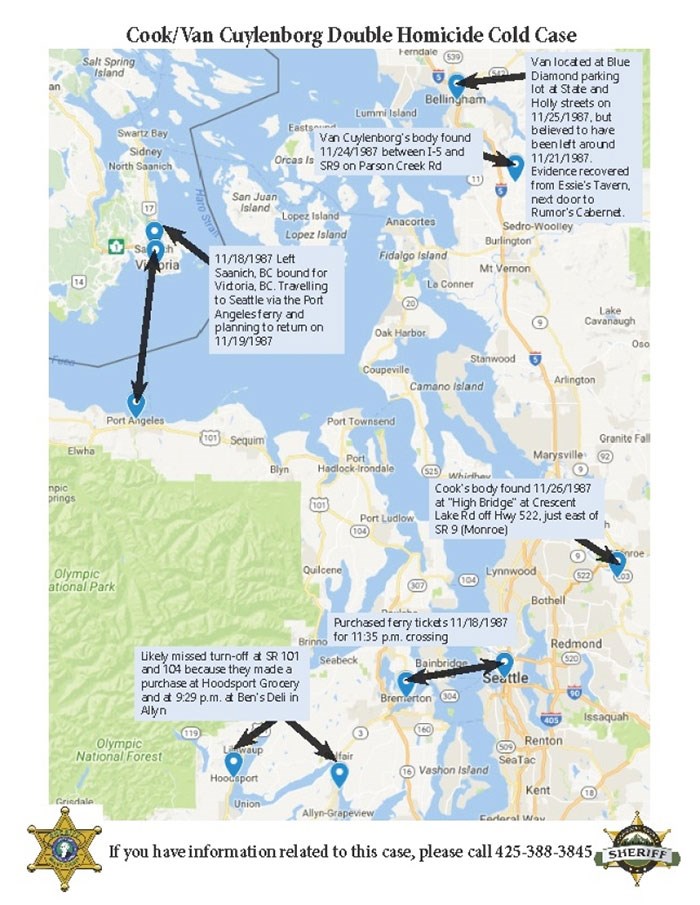 Composite drawings of the suspect at ages 25, 45 and 65. Photograph By Via Snohomish County Sheriff’s Office
Composite drawings of the suspect at ages 25, 45 and 65. Photograph By Via Snohomish County Sheriff’s Office
The Snohomish County Sheriff’s Office has released three composite sketches based on new DNA technology of the man who killed a young Victoria couple on a trip to Washington state more than 30 years ago.
At a news conference this morning, Sheriff Ty Trenary said investigators know how Oak Bay High graduates Tanya Van Cuylenborg, 18, and Jay Cook, 20, were killed in November 1987, but their killer has never been identified.
“Even though DNA was collected that DNA has not come back with a positive hit on any of the profiles in data bases used by law enforcement agencies,” said Trenary. “But using new DNA phentotyping technology we may be one step closer to identifying their killer.”
Police released sketches of the suspect at 25, 45, and 65 years of age. He is believed to be a white man of European descent with hazel or green eyes, light hair, freckles and possibly male pattern baldness.
Cook’s sisters, Kelly Cook and Laura Baanstra, and her husband Gary attended the news conference in Everett, Washington.
The technology is described as a forensic DNA analysis service that accurately predicts the physical appearance and ancestry of an unknown person from DNA. Snapshot is ideal for generating investigative leads, narrowing suspect lists, and solving human remains cases, the Snapshot DNA phenotyping website says.
The two Oak Bay High School graduates travelled from Victoria to Port Angeles on Nov. 18, 1987, via the Coho ferry. They had borrowed a van from Cook’s father to pick up furnace parts for him, and were last seen in the Bremerton-Seattle area. They were reported missing on Nov. 20, 1987.
On Nov. 24, 1987, Van Cuylenborg’s body was discovered in a ditch on a rural road near Alger in Skagit County. She had been sexually assaulted, then shot in the head. On Nov. 25, her wallet and keys were found discarded behind a Bellingham tavern. The van was located next to the Bellingham Greyhound bus station.
Then on Nov. 26, 1987, Cook’s body was discovered under a bridge near Monroe, Washington, northeast of Seattle and within sight of a minimum-security prison. He had been beaten and strangled.
Van Cuylenborg’s father said he believed the couple might have picked up a hitchhiker.
In 2015, investigators offered a $25,000 reward for information on the murders.
“What it is, really, is just an entirely new way to think about forensic DNA,” said Ellen Greytak, director of bioinformatics at Parabon NanoLabs, which used Snapshot DNA phenotyping to help the Snohomish County Sheriff’s Office on the cold case.
Greytak could not comment on the specific investigation, but explained that DNA phenotyping looks at pieces of DNA code to predict a person’s appearance, including their eye, skin and hair colour, facial features and ancestry.
 Map released by Snohomish County Sheriff’s Office shows events leading up to the murders of Tanya Van Cuylenborg and Jay Cook.
Map released by Snohomish County Sheriff’s Office shows events leading up to the murders of Tanya Van Cuylenborg and Jay Cook.
“Traditionally, DNA found at a crime scene is treated like a fingerprint, so you can use it to match that DNA to a database or to a suspect you’ve already identified. But if it doesn’t match either of those places, that DNA can’t tell you anything more,” she said.
This method treats the sample like a blueprint instead, Greytak said.
“It actually contains all the information that made that person and so if we can look at the person’s DNA and code for eye colour, face shape or ancestry, we can predict information about that person and give the investigators something they didn't have before.”
It allows DNA to be used as a “genetic witness” when there may not be a human witness, Greytak said.
“What this can do is provide a description of that person, objectively, just using the DNA and give them that information to go on that they didn’t have before,” she said.
The technology isn’t for individual identification, Greytak added, and there are traits it can’t predict, including age and body weight, so the company creates profiles of a young adult that can then be adjusted.
Their predictions can help police narrow down their suspect list and save time in an investigation, she said.
“We work on so many cases where, when we give the investigators our predictions, they say ‘Oh my gosh. We've been looking for someone completely different.’ ”
Greytak said the technology has been used in more than 150 cases around the world since it became commercially available in 2014.
Typically, the samples are blood or semen collected at a crime scene, but Greytak said they have also taken DNA from bones to create profiles of unidentified remains.
Police in Washington state have revisited the Cook and Van Cuylenborg case several times, and even opened their files to FBI profilers and homicide experts in Britain.
It took police 23 years to find the Canadian man they said wrote the families taunting letters about their children.
The man claimed he killed the couple and bragged he would never be caught. Police later determined he was mentally ill and not a suspect in the deaths.


